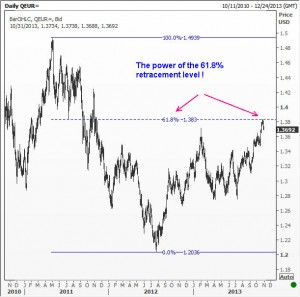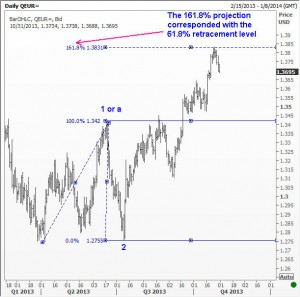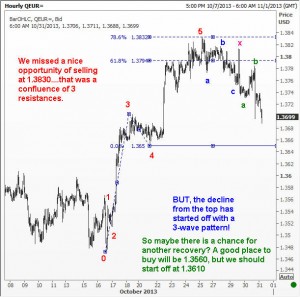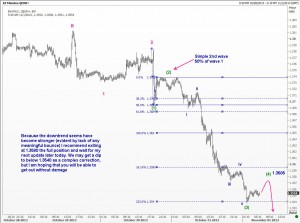As you know, this blog is there to help you learn how to use Elliott Waves. There are hundreds of examples of how one could be successful in the financial markets using this kind of technical analysis. There are also a few scattered examples of analysis that didn’t work out. Sometimes the analysis itself was wrong. At other times, the market just changed. The key point to bear in mind is one has to be consistent in his/her approach to trading in order to succeed. Also, success should be measured in the medium to long term. You cannot take just one or two trades and determine the method won’t work if you fail.Anyway, I thought it is a good idea to share with you a recent trade that members of the exclusive club took, and it didn’t quite go as per plan. Let us see how.
It was 31st October when I presented these charts. The first two showcased how wonderfully Elliott Waves were able to pinpoint accurately the top for the Euro. I used a 61.8% Fibonacci retracement and also confirmed its importance by measuring a 161.8% projection for the Wave C at 1.3820 levels.


But what is the next trade idea? I saw the structure of the waves from 1.3830 and it looked like a double zigzag. If you have read my book “Five Waves to Financial Freedom” you would know that when we get a zigzag correction it often ends up above the top of wave 1.This was at 1.3560. However, I was willing to risk some money at 1.3610. I also reasoned that the second zigzag could travel deep. You can see these notations on the following charts.

The plan was to buy in 2 stages. One third at 1.3610 and the rest at 1.3560 with a stop at 1.3535, risking 40 pips to make at least three times that. But when the Euro made a low of 1.3582 and didn’t look like it was going to bounce, I sent out an email that we should get out if there was a recovery to 1.3630, and buy the full lot at 1.3560 (same stops). The Euro stayed afloat for some time, but it soon reached the second buy level. The supports around 1.3550 held for several hours, but the writing was clearly on the wall. I sent out another email saying that it might be a good idea to get out near the break-even level. But for all intents the trade was a goner.

What is the lesson here? Firstly, Elliott Waves don’t guarantee a profit. It does allow you to take early action to mitigate your risks. And when you are on the right track, it pays you handsome dividends. Secondly, we should be willing to accept that something is going wrong and get out of the trade quickly when such signals are presented to you. We should not stay married to a losing trade. Elliott Waves help you in the divorce from your position!

